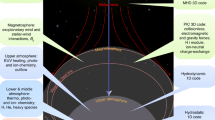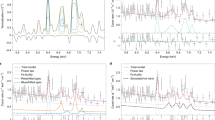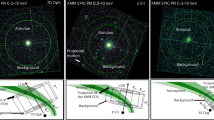Abstract
Absorption in the stellar Lyman-α (Lyα) line observed during the transit of the extrasolar planet HD 209458b in front of its host star reveals high-velocity atomic hydrogen at great distances from the planet1,2. This has been interpreted as hydrogen atoms escaping from the planet’s exosphere1,3, possibly undergoing hydrodynamic blow-off4, and being accelerated by stellar radiation pressure. Energetic neutral atoms around Solar System planets have been observed to form from charge exchange between solar wind protons and neutral hydrogen from the planetary exospheres5,6,7, however, and this process also should occur around extrasolar planets. Here we show that the measured transit-associated Lyα absorption can be explained by the interaction between the exosphere of HD 209458b and the stellar wind, and that radiation pressure alone cannot explain the observations. As the stellar wind protons are the source of the observed energetic neutral atoms, this provides a way of probing stellar wind conditions, and our model suggests a slow and hot stellar wind near HD 209458b at the time of the observations.
This is a preview of subscription content, access via your institution
Access options
Subscribe to this journal
Receive 51 print issues and online access
$199.00 per year
only $3.90 per issue
Buy this article
- Purchase on Springer Link
- Instant access to full article PDF
Prices may be subject to local taxes which are calculated during checkout



Similar content being viewed by others
References
Vidal-Madjar, A. et al. An extended upper atmosphere around the extrasolar planet HD209458b. Nature 422, 143–146 (2003)
Ben-Jaffel, L. Exoplanet HD 209458b: Inflated hydrogen atmosphere but no sign of evaporation. Astrophys. J. 671, L61–L64 (2007)
Vidal-Madjar, A. & Lecavelier des Etangs, A. in Extrasolar Planets: Today and Tomorrow, ASP Conf. Ser. 321 (eds Beaulieu, J.-P., Lecavelier des Etangs, A. & Terquem, C.) 152–159 (Astronomical Society of the Pacific, 2004)
Vidal-Madjar, A. et al. Detection of oxygen and carbon in the hydrodynamically escaping atmosphere of the extrasolar planet HD 209458b. Astrophys. J. 604, L69–L72 (2004)
Collier, M. R. et al. Observations of neutral atoms from the solar wind. J. Geophys. Res. 106, 24893–24906 (2001)
Futaana, Y. et al. First ENA observations at Mars: Subsolar ENA jet. Icarus 182, 413–423 (2006)
Galli, A. et al. First observation of energetic neutral atoms in the Venus environment. Planet. Space Sci. advance online publication doi: 10.1016/j.pss.2007.12.011 (1 January 2008)
Barth, C. A. Interpretation of the Mariner 5 Lyman alpha measurements. J. Atmos. Sci. 25, 564–567 (1968)
Barth, C. A. et al. Marine 6: Ultraviolet spectrum of mars upper atmosphere. Science 165, 1004–1005 (1969)
Lichtenegger, H. I. M. et al. Effects of low energetic neutral atoms on martian and venusian dayside exospheric temperature estimations. Space Sci. Rev. 126, 469–501 (2006)
Knutson, H., Charbonneau, D., Noyes, R. W., Brown, T. M. & Gilliland, R. L. Using stellar limb-darkening to refine the properties of HD 209458b. Astrophys. J. 655, 564–575 (2007)
Penz, T., Micela, G. & Lammer, H. Influence of the evolving stellar X-ray luminosity distribution on exoplanetary mass loss. Astron. Astrophys. 477, 309–314 (2008)
Preusse, S., Kopp, A., Büchner, J. & Motschmann, U. Stellar wind regimes of close-in extrasolar planets. Astron. Astrophys. 434, 1191–1200 (2005)
Preusse, S., Kopp, A., Büchner, J. & Motschmann, U. MHD simulation scenarios of the stellar wind interaction with Hot Jupiter magnetospheres. Planet. Space Sci. 55, 589–597 (2007)
Schneider, J., Rauer, H., Lasota, J. P., Bonazzola, S. & Chassefiere, E. Brown Dwarfs and Extrasolar Planets ASP Conf. Series 134 (eds Rebolo, R., Martin, E. L. & Zapatero Osorio, M. R.) 241–244 (Astronomical Society of the Pacific, Provo, Utah, 1998)
Yelle, R. V. Aeronomy of extra-solar giant planets at small orbital distances. Icarus 170, 167–179 (2004)
Yelle, R. V. Aeronomy of extra-solar giant planets at small orbital distances: Corrigendum Icarus. 183, 508 (2006)
García Muñoz, A. Physical and chemical aeronomy of HD 209458b. Planet. Space Sci. 55, 1426–1455 (2007)
Acknowledgements
This study was carried out within the framework of the International Space Science Institute team “Evolution of Exoplanet Atmospheres and their Characterization”. T.P. is supported by the Marie Curie Fellowship project ISHERPA and the host institution INAF—Osservatorio Astronomico di Palermo. H.L. thanks ASA for funding the CoRoT project. The research used the resources of HPC2N, Umeå University, and LUNARC, Lund University, Sweden. The software was in part developed by the DOE-supported ASC/Alliance Center for Astrophysical Thermonuclear Flashes at the University of Chicago.
Author Contributions A.E. wrote an initial version of the simulation code. F.S. helped in modelling the observation. T.P. provided knowledge on the atmospheres of extrasolar planets. H.L. suggested that the HST observation could be due to ENAs. P.W. contributed expertise in ENA processes
Author information
Authors and Affiliations
Corresponding author
Supplementary information
Supplementary Information
This file contains Supplementary Notes with Supplementary Figures 1-7 and Supplementary Tables 1-2. It describes the algorithms used to simulate HD 209458b's hydrogen exosphere, the detailed setup used in the numerical experiments, and finally it investigates the effects of changing some model parameters. (PDF 446 kb)
Rights and permissions
About this article
Cite this article
Holmström, M., Ekenbäck, A., Selsis, F. et al. Energetic neutral atoms as the explanation for the high-velocity hydrogen around HD 209458b. Nature 451, 970–972 (2008). https://doi.org/10.1038/nature06600
Received:
Accepted:
Issue Date:
DOI: https://doi.org/10.1038/nature06600
This article is cited by
-
The Exosphere as a Boundary: Origin and Evolution of Airless Bodies in the Inner Solar System and Beyond Including Planets with Silicate Atmospheres
Space Science Reviews (2022)
-
The evolution of the solar wind
Living Reviews in Solar Physics (2021)
-
Partially Ionized Plasmas in Astrophysics
Space Science Reviews (2018)
-
Formation and Evolution of Protoatmospheres
Space Science Reviews (2016)
-
A giant comet-like cloud of hydrogen escaping the warm Neptune-mass exoplanet GJ 436b
Nature (2015)
Comments
By submitting a comment you agree to abide by our Terms and Community Guidelines. If you find something abusive or that does not comply with our terms or guidelines please flag it as inappropriate.



